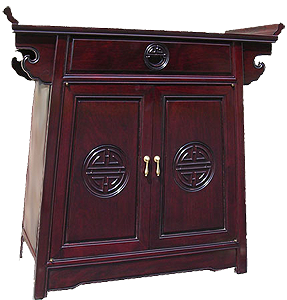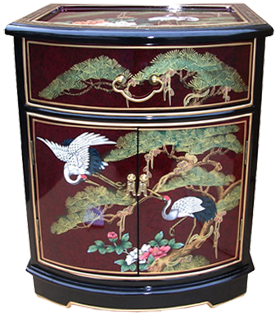shop by
Categories
Caring for your Oriental Furniture
Making minor touchups and repairing stains on your Oriental furniture
Furniture Repairs: Improper restoration of Chinese table
Finishes on Asian furniture may vary from soft oil finishes to hard finishes, including opaque painted finishes and clear finishes, lacquer, shellac, varnish or those containing polyurethane for added strength.
Determining the type of finish on your Oriental furniture piece

It's important you know the type of finish in your Asian furniture piece in order to properly care for it. Remember that it's the finish you are cleaning, not the wood itself. If you are in doubt about the type of finish, try the following tests in an inconspicuous part of the piece.
Testing for type of finish on your furniture
Test for an oil finish by rubbing a few drops of boiled linseed oil into the wood.
If it absorbs, the wood has an oil finish.
If it beads up, the wood has a hard finish.
To identify which hard finish, rub acetone over a spot in a gentle, circular motion.
- Lacquer finishes, popular in Oriental furniture, will dissolve in 30 seconds under gentle, circular rubbing.
- Varnishes and shellacs will turn to a sticky, gel-like substance after a minute or two
- polyurethane/polyester finishes will shed acetone like water.
(A shellac can be distinguished from a varnish because shellacs will dissolve quickly in denatured alcohol; varnish will react more slowly.)
LACQUER FINISH

After you have decided which finish is on your Asian furniture piece, follow the appropriate procedures given below for routine and special maintenance.
For All Furniture Finishes: Dust several times a week in order to maintain a clean surface and protect the finish from soil build up. Use a clean, lint-free, absorbent cloth for general dusting.
Protect all furniture from direct sunlight.
Exposure to the sun's rays can dry out the wood and actually bleach out the color of your fine Oriental furniture pieces.
Wood breathes as we do. Avoid putting your Asian furniture in extremely moist or dry air. Use a humidifier or dehumidifier when needed to help keep wood from drying out or warping. Also, don't place your wood furniture near air vents; the forced air will adversely affect the wood.
Cover the bottoms of your Oriental accessories and other tabletop items with felt to prevent scratching. Use coasters under glasses to prevent water marks. Never let water stand on a wood surface, and always use a protective plate under flower vases filled with water to keep moisture from drawing into your Oriental furniture piece.
Wash your Asian furniture surfaces once a year with a sudsy solution of mild soap and water. Using a clean, soft cloth from which most of the water has been wrung, work on a small area at a time, overlapping areas as you work. Clean with the sudsy solution, then rinse with a soap-free dampened cloth, and dry immediately with a soft, lint-free cloth.
PROTECTION POLISH
After washing your Oriental furniture, and for occasional polishing, mix equal parts of boiled linseed oil and gum turpentine and apply to the wood surfaces with a coarse, lintless cloth, such as cheesecloth. Rub briskly until the wood is completely dry and a sheen appears. Let the oil soak into the wood. Reapply if necessary.
For new Oriental furniture, apply once a month for three to four months, then apply twice a year or as needed.
For older furniture, use a mixture of two parts of boiled linseed oil and one part gum turpentine every six to eight months. Rub especially on the tops of tables, and to the underside of table leaves to prevent warping.
For All Hard Finishes:
Lacquers, varnishes, shellacs, polyurethane/polyester finishes, as well as painted surfaces can all be protected with waxes or polishes. Select the wax or polish according to the level of gloss or sheen you desire. Do not mix products as a dull film may result. To remove an inappropriate wax or finish, clean the piece with cleaner-conditioner, then apply the appropriate finish protection.
A paste wax or an aerosol or liquid polish containing silicone will create a high gloss on your Oriental furniture pieces. Paste waxes offer the best protection and with consecutive applications and a lot of buffing, provide a beautiful high gloss. Paste wax is recommended for fine antiques with a hard finish. It is available made from beeswax, a softer, more nourishing wax, and carnauba, a tougher, harder wax. Paste wax comes in various shades, from dark to light, to blend in with the tone of the wood. Clear waxes are also available for painted surfaces.
Aerosol or liquid polishes which contain silicones offer high gloss with very little buffing, clean as well as shine and give the wood a durable protective finish. However, silicones are rather difficult to remove and, therefore, can complicate the process of refinishing in the future. They also tend to show finger smudges more readily and need more frequent applications to maintain the gloss, causing a heavier silicone buildup. Satin-gloss and low-gloss finishes are best achieved and maintained by the use of cream waxes or liquid cleaning polishes which do not contain silicones. Oil polishes can be used as well, but require more rubbing and attract dust quickly.
In sum, with a little care, your Oriental furniture will give you many years of pleasure with a small amount of maintenance.
Please stop by Oriental Furniture, 602 West Ave, Norwalk, Conneticut, 06850 for tips on Chinese Furniture Repairs.


